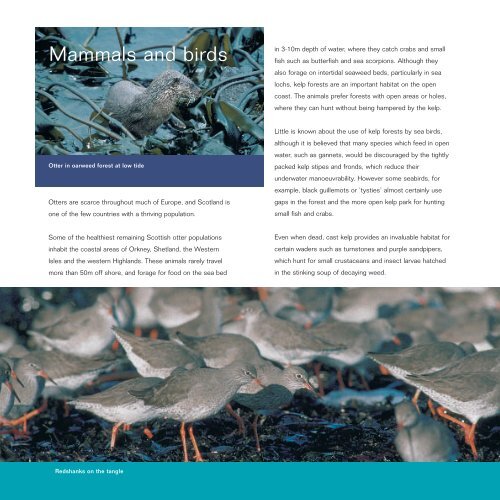Kelp Forests - Scottish Natural Heritage
Kelp Forests - Scottish Natural Heritage
Kelp Forests - Scottish Natural Heritage
You also want an ePaper? Increase the reach of your titles
YUMPU automatically turns print PDFs into web optimized ePapers that Google loves.
Mammals and birds<br />
Otter in oarweed forest at low tide<br />
Otters are scarce throughout much of Europe, and Scotland is<br />
one of the few countries with a thriving population.<br />
Some of the healthiest remaining <strong>Scottish</strong> otter populations<br />
inhabit the coastal areas of Orkney, Shetland, the Western<br />
Isles and the western Highlands. These animals rarely travel<br />
more than 50m off shore, and forage for food on the sea bed<br />
Redshanks on the tangle<br />
in 3-10m depth of water, where they catch crabs and small<br />
fish such as butterfish and sea scorpions. Although they<br />
also forage on intertidal seaweed beds, particularly in sea<br />
lochs, kelp forests are an important habitat on the open<br />
coast. The animals prefer forests with open areas or holes,<br />
where they can hunt without being hampered by the kelp.<br />
Little is known about the use of kelp forests by sea birds,<br />
although it is believed that many species which feed in open<br />
water, such as gannets, would be discouraged by the tightly<br />
packed kelp stipes and fronds, which reduce their<br />
underwater manoeuvrability. However some seabirds, for<br />
example, black guillemots or ‘tysties’ almost certainly use<br />
gaps in the forest and the more open kelp park for hunting<br />
small fish and crabs.<br />
Even when dead, cast kelp provides an invaluable habitat for<br />
certain waders such as turnstones and purple sandpipers,<br />
which hunt for small crustaceans and insect larvae hatched<br />
in the stinking soup of decaying weed.

















